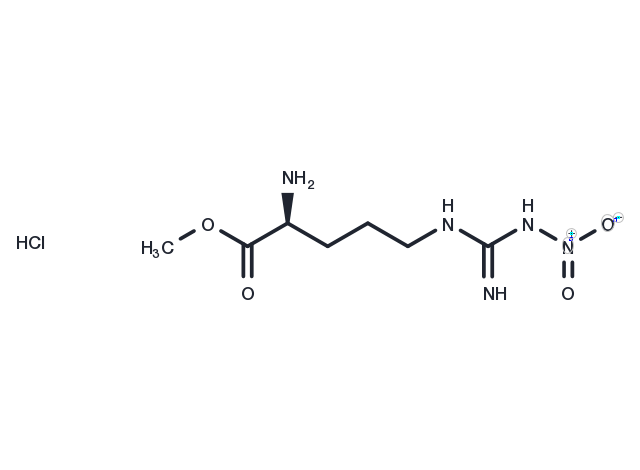store at low temperature
Powder: -20°C for 3 years | In solvent: -80°C for 1 year

L-NAME hydrochloride (L-NAME HCl), a cell-permeable NO synthase inhibitor, displays Ki values of 4.4 μM, 15 nM, and 39 nM, for iNOS (mouse) , nNOS (bovine) , and eNOS (human), respectively.

| Pack Size | Availability | Price/USD | Quantity |
|---|---|---|---|
| 100 mg | In stock | $ 46.00 | |
| 200 mg | In stock | $ 54.00 | |
| 500 mg | In stock | $ 76.00 | |
| 1 mL * 10 mM (in DMSO) | In stock | $ 30.00 |







| Description | L-NAME hydrochloride (L-NAME HCl), a cell-permeable NO synthase inhibitor, displays Ki values of 4.4 μM, 15 nM, and 39 nM, for iNOS (mouse) , nNOS (bovine) , and eNOS (human), respectively. |
| Targets&IC50 | nNOS:15 nM(Ki), eNOS:39 nM(Ki) |
| In vivo | L-NAME (0.03-300 mg kg-1, i.v.) induces a dose-dependent increase in mean systemic arterial blood pressure accompanied by bradycardia. L-NAME (100 mg kg-1, i.v.) inhibits significantly the hypotensive responses to ACh and bradykinin. The increase in blood pressure and bradycardia produced by L-NAME is reversed by L-arginine (30-100 mg kg-1, i.v.) in a dose-dependent manner. [2] |
| Kinase Assay | Enzyme Assay: The oxidation of L-arginine is monitored by the conversion of [3H]- or [14C]-arginine to L-citrulline which separates L-citrulline from L-arginine by Dowex 50x8-200 (Na) chromatography. Typical reaction mixtures (100 pL) contains 50 mM HEPES, pH 7.0, 8 pM tetrahydrobiopterin, 1 mM CaC12, 0.01 mg/mL calmodulin, 0.5 mM EDTA, 0.450 pM [14C]-arginine (30000 cpm), and 100-200 pM NADPH. The cNOS-catalyzed oxidation of NADPH to NADP+ is monitored by the reduction of absorbance at 340 nm with a Kontron 860 spectrophotometer in a volume of 300 pL. All reactions are at 30 ℃ unless otherwise indicated. |
| Cell Research | rMC-1 cells are incubated in 5 or 25 mM glucose, with or without l-NAME (1 mM). Media is changed every other day for up to 5 days. BREC cells are incubated in 5 or 25 mM glucose as well as inhibitor as described above for 5 days. Cell death is determined by light microscopy using a hemocytometer and a 0.4% trypan blue dye exclusion method. The number of cells that do not exclude the dye is expressed per 1,000 total cells. A minimum of 800 cells is counted per assay (8 dishes, >100 cells counted per dish), and the assay is replicated three times on different days. (Only for Reference) |
| Synonyms | L-NAME HCl, N(G)-Nitro-L-arginine methyl ester, NG-Nitroarginine methyl ester hydrochloride |
| Molecular Weight | 269.69 |
| Formula | C7H15N5O4·HCl |
| CAS No. | 51298-62-5 |
store at low temperature
Powder: -20°C for 3 years | In solvent: -80°C for 1 year
DMSO: 27 mg/mL (100 mM)
H2O: 27 mg/mL (100 mM)
You can also refer to dose conversion for different animals. More
bottom
Please see Inhibitor Handling Instructions for more frequently ask questions. Topics include: how to prepare stock solutions, how to store products, and cautions on cell-based assays & animal experiments, etc.
L-NAME hydrochloride 51298-62-5 Immunology/Inflammation NO Synthase NOS L-NAME HCl inhibit NG-Nitroarginine methyl ester Hydrochloride Inhibitor L-NAME Nitric oxide synthases L-NAME Hydrochloride LNAME hydrochloride L NAME hydrochloride NG-Nitroarginine methyl ester N(G)-Nitro-L-arginine methyl ester NG-Nitroarginine methyl ester hydrochloride inhibitor
